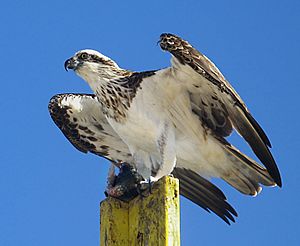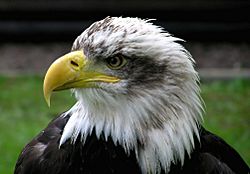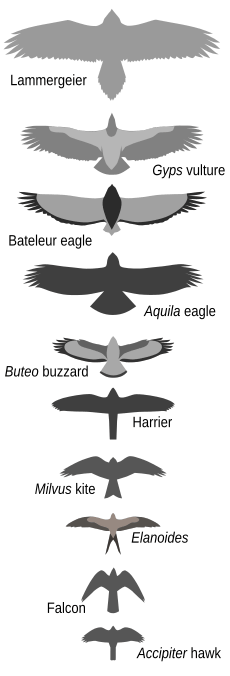Bird of prey facts for kids
Quick facts for kids Birds of prey |
|
|---|---|
 |
|
| Australasian Osprey | |
| Scientific classification | |
| Kingdom: | |
| Phylum: | |
| Class: | |
| Orders | |
Birds of prey, also known as raptors, are amazing birds that mostly hunt other animals. They use their strong, sharp claws, called talons, to catch their food. These birds are not all from the same family group. Instead, many different types of birds have developed these hunting skills over time. This is like different animals finding similar ways to solve a problem, which scientists call convergent evolution.
Contents
What Are Birds of Prey?
Birds of prey are known for their excellent eyesight, powerful talons, and hooked beaks. These features help them find, catch, and eat their prey. They can be found all over the world, living in many different habitats from forests to deserts.
Daytime Hunters: Diurnal Raptors

Some birds of prey are active during the day. These are called diurnal raptors. They belong to two main groups, or "orders," called Falconiformes and Accipitriformes.
Here are some of the families in these groups:
- Accipitridae: This big family includes many well-known birds like hawks, eagles, buzzards, harriers, kites, and Old World vultures.
- Pandionidae: This family has just one special bird, the osprey, which is famous for catching fish.
- Sagittariidae: This family also has only one bird, the secretary-bird, known for its long legs and hunting snakes.
- Falconidae: This group includes fast-flying birds like falcons, caracaras, and Forest Falcons.
Nighttime Hunters: Owls
Other birds of prey are active at night. These are called nocturnal raptors. The most famous nocturnal birds of prey are the owls. They belong to their own special order called Strigiformes.
There are two main families of owls:
- Strigidae: These are the typical owls you might imagine, with round faces and big eyes.
- Tytonidae: This family includes barn owls and bay owls, which often have heart-shaped faces.
Types of Birds of Prey
Let's look at some common types of raptors and what makes them special:
- Eagles: These are very large birds with wide wings and strong feet. Many eagles have feathers all the way down their legs. They build huge nests out of sticks high up in trees or on cliffs.
- Ospreys: There's only one species of osprey, and you can find it almost anywhere in the world. Ospreys are expert fishers. They dive feet-first into the water to grab fish with their powerful talons. They also build large stick nests.
- Kites: Kites have long wings and are very good at soaring high in the sky. They often eat insects and dead animals (carrion), but they can also catch small live animals.
- Hawks: These are medium-sized birds of prey. Many hawks belong to the group called Accipiter. They often live in woodlands and hunt by making quick, sudden dives from a hidden spot. They usually have long tails, which help them steer quickly through trees.
- Buzzards: In some parts of the world, like Europe, buzzards are sturdy birds with broad wings. In North America, birds called "hawks" are often actually buzzards (from the genus Buteo).
- Harriers: Harriers are slender, hawk-like birds with long tails and thin legs. They fly low over grasslands and marshes, looking for small animals to catch. They have long, broad wings that help them glide and circle.
- Vultures: Vultures are unique because they mostly eat carrion (dead animals). There are two different groups of vultures that evolved separately:
- The Accipitridae vultures are found in the Eastern Hemisphere (like Africa and Asia).
- The Cathartidae vultures are found in the Western Hemisphere (like North and South America).
Both groups have heads that are partly or fully without feathers. This helps them stay clean when they eat.
- Falcons: Falcons are small to medium-sized birds of prey with long, pointed wings. They are known for being incredibly fast flyers. Unlike most other raptors, falcons don't usually build their own nests. They often use old nests made by other birds, or lay their eggs on cliff ledges or in tree hollows. A subgroup of falcons called Caracaras are found only in the Americas, especially in tropical areas.
- Owls: Owls are hunting birds that come in many sizes. They are mostly active at night. Owls can fly almost silently and have amazing hearing and eyesight, which helps them hunt in the dark.
Images for kids
-
The Strait of Messina in Sicily is a narrow place where many birds of prey fly during their migration.
See also
 In Spanish: Ave de presa para niños
In Spanish: Ave de presa para niños



